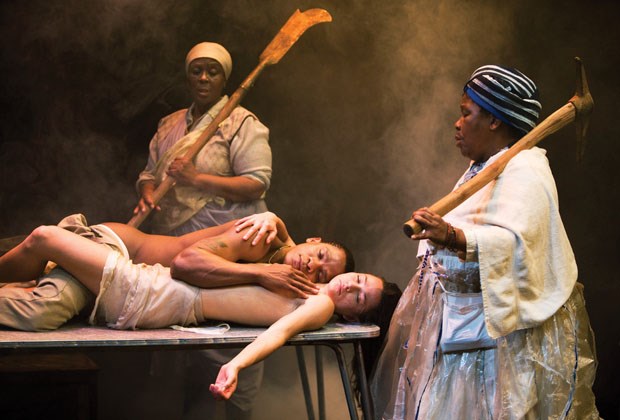Mies Julie, March 25 to April 19 at The Cultch, 1895 Venables St., Vancouver. Tickets available at thecultch.com or 604-251-1363
The tree isn’t dead.
It should be. After the punishment it’s endured and the nourishment it’s been denied it should be cold in the ground.
Only it isn’t. It’s growing, spreading its branches and breaking through kitchen floorboards as it reaches for the sun.
That singular image of a tree rising like a zombie is the genesis for writer/director Yael Farber’s Mies Julie. Set on Freedom Day in post-apartheid South Africa, Farber’s play re-works Swedish playwright August Strindberg’s sensation of 1888, Miss Julie.
Julie, white, is the young, reckless, heiress to the land. Bored and half-drunk, she casts her entitled gaze on her black servant, John.
John and Julie grew up together. Julie owns the land. John’s ancestors are buried in the soil beneath the farmhouse.
“In this domestic heat we spend a night confronting all that apartheid has left as its residue,” Farber writes in an email.
Farber read Strindberg’s love triangle at a Johannesburg drama school when she was a student.
“It made very little impression,” she writes. “I do, however, remember thinking it would be a striking story to tell in South Africa. I did not think of it again for the next 20-odd years.”
When she did think of the play, she thought of the tree.
“Powerful pictures always come before words. They are my true north,” she writes.
Although she found Strindberg’s words “rather tame,” Farber was moved by the story’s brutality and brutal honesty.
“The catalyst for this searing honesty between them — despite their social differences — is the brewing and finally consummated sex.”
A review in the New Yorker praised Farber’s script but blasted her direction for turning the play into pornography.
As a writer, Farber says Ernest Hemingway is often in the room with her, reminding her that a writer’s job is to tell the truth.
Farber’s Mies Julie takes place in the kitchen of a farmhouse in the arid climes of the semi-desert Karoo.
The play is intended to deal with land redistribution in South Africa, according to Farber.
The land itself is harsh, sort of like America’s breadbasket in the days when the region stood on the brink of the dust bowl.
“If you are tender out here, you drown,” Julie says.
She is referring to the suicide of her mother. Because of her mother’s death, Julie was largely raised by Christine, John’s mother.
“Most white South Africans will have been tended to by a black mother in their childhood,” Farber explains.
In Strindberg’s original, Christine is Jean’s (John’s) fiancé. But rather than examining a romantic complication, Farber is more interested in John’s familial ties.
“Christine as a mother creates a far more powerful figure of accountability in John’s life than a fiancé would have,” Farber writes. “John is beholden to hi ancestors.”
Christine is the one who taught John where his ancestors were buried. It’s because of her lessons that John can call Julie’s forefathers “squatters.”
The Republic of South Africa has changed for the better in the last two decades, but the past is still alive in that stretch of land between the Atlantic and Indian Oceans.
“The shrapnel of those years — the loss of what can never be replaced — lives on,” Farber writes.
Both John and Julie are bound. John by his history and Julie by her attitude of superiority, however, the play is optimistic.
“What I have written is a piece that continually shows how love is at the core of John and Julie’s relationship. That redemption and a future are possibly . . . if they are capable of dropping the opposing narratives they have inherited.”



